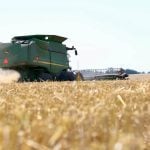While it might have rained where you are, the impact of drought on the effectiveness of herbicides likely remains.
This week we look at water, which is the primary carrier for herbicide applications. In fact, it usually makes up more than 99 percent of the spray solution.
Considering that, it should be no surprise that the chemistry of water added to the spray tank greatly affects herbicide effectiveness. It is also no surprise that drought affects water quality of surface water sources such as sloughs and dugouts. As water evaporates from these sources, mineral concentrations increase, magnifying water quality issues.
Read Also

GSI’s GrainVue allows for remote grain bin monitoring
GSI’s GrainVue bin monitoring system allows producers to monitor grain conditions inside the bin and automate any drying, cooling or aerating that is needed to keep grain in peak condition.
Let’s first take a look at how water quality affects herbicide performance.
There are three major areas where water quality affects herbicides: water hardness, dissolved bicarbonates and water pH and turbidity, which is suspended silt, clay and organic matter. All three of these can be affected by drought or dry conditions in surface water.
Hard water contains high levels of calcium, magnesium or sodium. Other cations can cause hard water, but these are the usual suspects on the Prairies.
Calcium, magnesium and sodium cations, which have positively charged ions, attach to negatively charged herbicide molecules. Often, the association between herbicides and these cations renders the herbicide ineffective.
Hard water is usually associated with deep wells, but sloughs and dugouts can also have hard water, especially in areas where the water source comes from saline areas. Dugouts that are cut into saline water tables can have very high electrical conductivity values. If a dugout remains full even in times of extended drought, there is a distinct possibility that it is highly mineralized.
The hardness of surface water is in almost direct proportion to the total dissolved solids (EC). If the EC is less than 500 microsiemens per centimeter, it is unlikely that the efficacy of any herbicide will be affected. For herbicide dilution interpretations, the type of minerals dissolved in the water is the most important consideration.
When hard water is a concern, do not cut rates. Use the maximum recommended rate of herbicide. Ammonium sulfate fertilizer, 21-0-0-2, can be added at a rate of three kilograms of fertilizer per 100 litres of water and will help to overcome the antagonistic effect of hard water on these products.
Glyphosate and 2,4-D amine are two herbicides that can be heavily affected by hard water.
Dissolved bicarbonates are most commonly encountered in well water. High levels of bicarbonates can affect the performance of certain herbicides. The DIM herbicides, such as Poast (sethoxydim), Achieve (tralkoxydim) and Select-Centurian (clethodim) show reduced efficacy on weeds when levels of sodium bicarbonate is more than 500 parts per million. Other herbicides, such as Puma-Horizon (clodinafop) and Assure (quizalofop) are not affected.
Water pH is also important. Some pesticides are deactivated in a matter of minutes in water with certain pH levels. If water is too acidic, where pH levels are below seven, the sulfonylureas such as Refine, Ally and Express are deactivated if left in the spray solution for prolonged periods.
Some products such as Assert come with a water pH modifier to ensure that a proper pH is achieved.
The pH of surface water may change under drought conditions. Last year’s water might not be this year’s.
Turbid water, which contains suspended solids, soil or organic matter, can reduce effectiveness of post-emergence herbicides. Water should be clean and clear for all pesticide applications, but some pesticides are not as sensitive to turbidity as others.
Pesticides are measured for their ability to bind to soil particles. This information is typically used to assess their potential for off-site movement or leaching through the soil profile and expressed as a Koc value, or soil organic carbon-water partitioning coefficient.
Glyphosate and others such as Reglone (diquat), Gramoxone (paraquat) and Pardner- Buctril M-Infinity (bromoxynil) have very high Koc values. Because of their high Koc, these herbicides will bind to soil and organic matter particles suspended in water and will not be available for absorption into weed foliage. Comparatively, Banvel (dicamba) has a low Koc and has been found to be relatively unaffected by suspended solids in spray water.
The turbidity of water often increases during periods of drought.
Labs such as ALS Labs Saskatoon, AGAT Labs in Calgary, AgVise Labs in Northwood, North Dakota, and Benson, Minnesota or A and L Labs in London, Ont., will provide an analysis of water to see if there may be limitations for use in herbicide applications.
When ordering a test, request the agricultural spray water analysis and use the recommendations or the information presented here to assess the suitability of the water for spraying purposes.
















